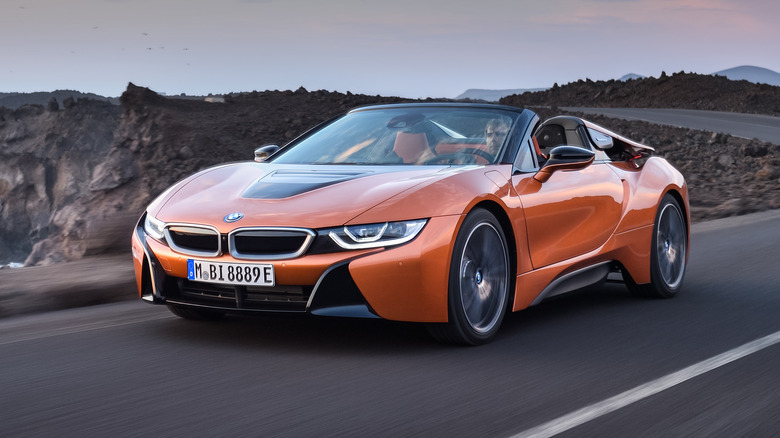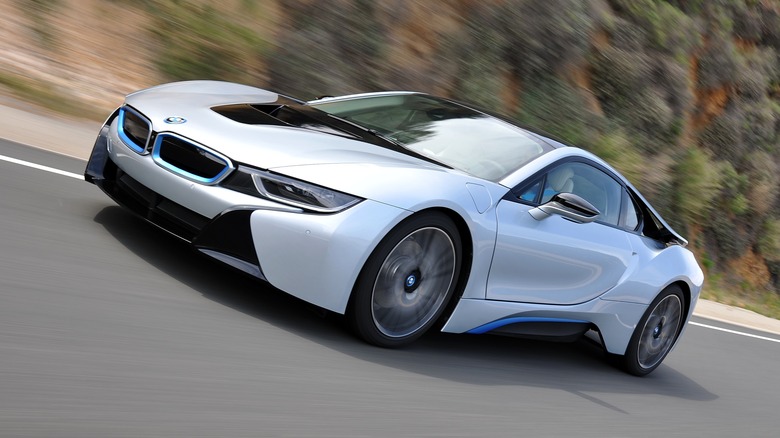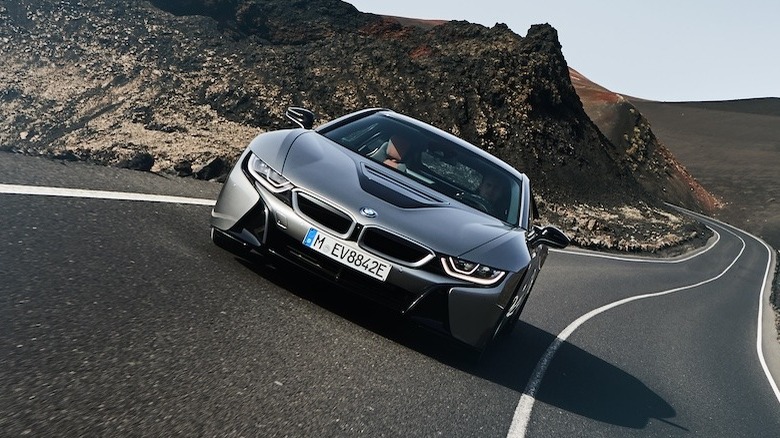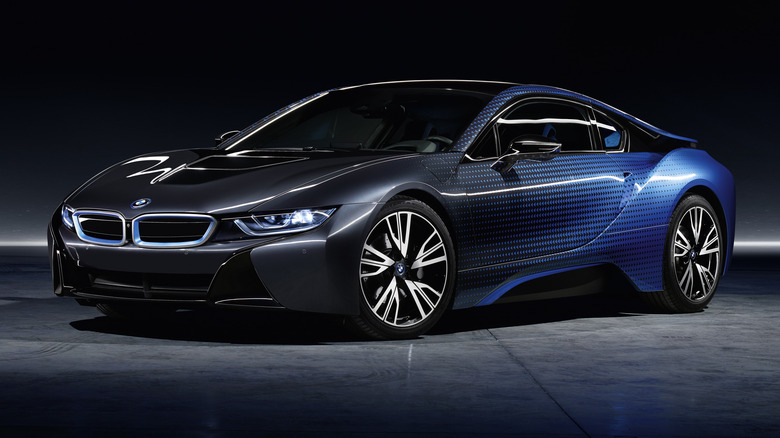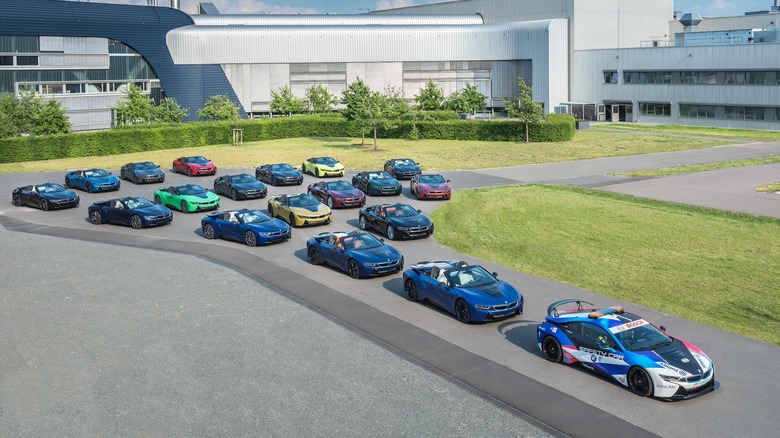Here's Why The BMW i8 Was Discontinued
More and more car companies are moving toward electric vehicles. It doesn't really matter where the company is based or what economic market it's catering to. There is just a strong push towards EVs, whether the motivation is to be more environmentally conscious, latch onto a trend, or just diversify the fuel options available to their customers. One of the companies that has built up a fairly solid line of EVs is the German automaker BMW. As of right now, the company has four all-electric vehicles in its stable under what is called the "i" brand. With the exception of the iX, which was purposefully built to be an electric vehicle, the other i-branded vehicles, such as the i7, are just electric versions of BMW vehicles that can also be gas-powered.
The BMW i stable used to feature other vehicles as well. One of those was the BMW i8, which debuted in the 2014 model year and was discontinued after 2020. This was the sole sports car offered on the line, and it received a healthy amount of praise over the years, including from SlashGear. The BMW i8 was an aesthetically beautiful luxury vehicle that seemed like it could be at the forefront of the company's i brand. However, it was quietly pushed aside after just a few years. BMW has not explicitly stated why it ceased production on the i8, which leaves us to wonder about why and how this could have happened. Well, that's exactly what we're going to do. Let's go back to the BMW i8's time in the sun and see if we can figure out where it all went wrong.
Not an all-electric vehicle
While the rest of the BMW i line are all-electric vehicles, that was not the case with the i8. Instead, the sports car was a plug-in hybrid, which exists in the space between a hybrid and an all-electric vehicle. As the name implies, you can connect the vehicle to a wall outlet to charge the battery, and for the i8, a full charge allows you to travel 22 miles on a single charge. Once the it's depleted, it pulls its power from a traditional petrol engine.
The plug-in hybrid system may be great for some people. If you look at the rest of the BMW i line, though, the i8 stands out like a sore thumb. The company has other plug-in hybrids available, such as the 330e sedan or the XM SUV, but making the model part of its i stable complicates what that branding means. People could very well have been expecting to buy themselves an all-electric BMW luxury sports car, yet when they got to the dealership, they found out it didn't exist.
If they got an i8, they would have to keep purchasing gasoline. Granted, the vehicle is still a hybrid, so they would be purchasing it less often. But that doesn't change the fact that they would be making regular gas payments they might have hoped to stop making, either for financial or environmental reasons. Because this is a sports car, it might be used for more than everyday errands, which would mean more money spent on fuel. A plug-in hybrid isn't a bad idea, but branding it alongside all-electric vehicles is somewhat misleading.
A very expensive proposition
Most people expect to walk into a BMW dealership and wind up with a vehicle that makes a sizable dent in their bank account. This is an automaker that specializes in luxury vehicles, and the prices reflect that. The cheapest BMW model available is a 228i coupe, and at its most base-level, its MSRP is $38,400. Most models, however, are anywhere from a few thousand dollars to tens of thousands more. For example, the high performance sports car version of the 230i coupe, the M2, has a starting price of $63,200. These are not cheap vehicles.
Even by the standards of BMWs, the i8 was an enormous investment. The starting price was a whopping $136,650. In 2024, just a decade since its debut, that's $181,288 when adjusted for inflation. For comparison, the current BMW i7 has a starting price of $105,700, and it's a fully electric vehicle. By making a car that expensive, you're severely limiting your market appeal, and the sales reflected that.
Initially, things started off decently well, with BMW selling 1,741 units of the i8 around the world in 2014 after having launched partway through the year. The following year, the company sold 5,456 units with a full 12 months on the market. After that, sales started drying up. In 2017, not even 500 units were sold in the United States. Those who could afford a BMW i8 and desired the newest, shiniest product off the line had already purchased it, and finding new customers to buy-in proved difficult.
Not a powerhouse sports car
People decide to purchase a luxury sports car for a couple of different reasons. For some, it's the aesthetic beauty in the sleek look. However, the big appeal for a vehicle like this is its power. When you get behind the wheel of one, you're looking for a high-performance ride with speed and strength that you simply can't get in your average sedan or coupe. But even though the BMW i8 was a sports car, its high performance capabilities were not exactly off the charts when compared to other options of the time, and that even includes other vehicles made by BMW itself.
The BMW i8 was able to generate 357 horsepower upon its initial 2014 release, and with the introduction of the Coupe and Roadster models in 2018, that was increased to 374 horsepower. Those are fine numbers, but you aren't exactly making speed fiends excited to drop over $130,000 for that. To use a similarly priced BMW performance vehicle of the time, let's examine the 2014 BMW M6 Gran Coupe, which had an output of 560 horsepower with its 4.4L V8 engine. This is a car that had a starting price of $115,225, which is still a lot of money — but considerably less than the i8. Even the 2015 M3 outpaced the i8 with 425 horsepower with its 3.0L I6, and it cost just $67,250. When it came to the BMW i8, you were paying a premium, but that premium wasn't for power.
The end of the BMW i8
The final BMW i8 models were produced in June 2020, just six years after they first hit the market. What seemed like it could be the tantalizing luxury car of the time ended up as a high-priced vehicle with a beautiful design and a limited appeal. All of these factors — its price, its average powertrain, and it being a plug-in hybrid and not an all-electric vehicle — must have contributed to its short life within the BMW i line of vehicles.
BMW announced that it would be ceasing production on the i8 on March 11, 2020. This also happened to be the day that the NBA suspended its regular season and effectively set the rest of the world on notice that COVID-19 was here and a major problem, leaving us to be locked up in our homes indefinitely. It was probably completely coincidental — the company might have been planning on making the decision for a while. Nevertheless, our priorities became stockpiling toilet paper and hand sanitizer, and the idea of purchasing an incredibly expensive sports car couldn't have been further from our minds. After all, there was no place open to drive it to.
In 2020, BMW sold just 192 i8 units in the United States. Looking back, the company ceased production on its plug-in hybrid sports car just in time. If the company hadn't killed it, the pandemic probably would have anyway.
